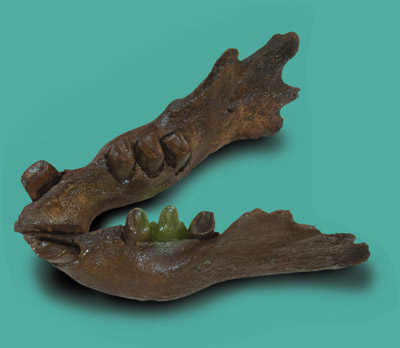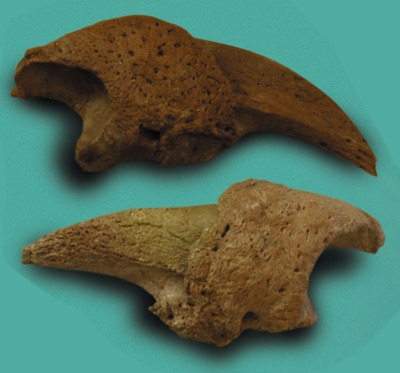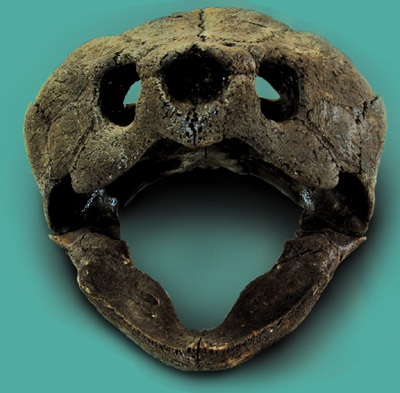|
| |
|
|
|
|
Editorial by Andreas Kerner
Photography by Curt Bowen |
|
|
|
Florida’s numerous rivers, lakes, and creeks contain a wealth of fossils, dating back to more than 40 million years. Technically speaking, the term “fossil” covers any remains of organic life, from bones and teeth of vertebrates to shells, sea urchins, and fossil plants. Our company specializes in recovery, preparation, and identification of these relics of the past. Our main focus is on vertebrates of the Pleistocene to Miocene — a time span covering roughly the last 10 million years. We work closely with the Florida Museum of Natural History (FLMNH) at the University of Florida in Gainesville, and we frequently donate important specimens to their comparative collection. Several new species, previously unknown to science, have been discovered by us and are currently being scientifically described.
Fossils can be found almost anywhere in Florida. Construction sites and shell pits are a great place to check, but since you bought this magazine, you most likely spend quite a bit of time underwater. The good news is — as a diver, you have access to the best fossil-bearing deposits imaginable. Unfortunately, you can’t just plunge into any body of water and find a complete Mastodon skeleton (though it does happen from time to time).
|
|
|
|
Photo: Andreas Kerner with a fossil skull of a monstrous Alligator, Alligator mississippiensis, from the early Pleistocene (Irvingtonian) of Charlotte Co., FL. The fossil is about 1.8 million years old. |
|
|
|
 |
| • Lower jaw of Megalonyx leptostomus, a rare species of ground sloth from the Blancan (late Pliocene). About 2.2 million years old. |
|
|
 |
| • Two fossil ground sloth claws from the late Miocene. Pliometanastes protistus (top) and Thinobadistes segnis. About 7 million years old. |
|
|
 |
| • Skull and lower jaw of Macroclemys temminckii, a large Alligator Snapping Turtle. Late Pleistocene, about 15,000 years old. Almost 9 inches wide. |
|
|
 |
| • American Mastodon, Mammut americanum. Palate with upper dentition of a sub-adult male prior to restoration. Most vertebrate fossils have to be restored and/or hardened with preservatives after recovery. Early Pleistocene, Irvingtonian. About 1.5 million years old. |
|
|
|
The problem is that some animals were a lot more abundant than others and lived in an environment more favorable for fossilization. A good example is the group of fossils commonly referred to as “echinoids,” sand dollars and sea urchins, among others. Some Eocene limestone outcrops in sinkholes or river bottoms are literally full of them. Even though these are some of the oldest fossils you can find in Florida, they are usually far from being rare. The trick is to find that one that looks a little odd or different than the others. This may be a different species and could be of scientific interest. Vertebrate remains in these early and typically marine deposits are rather uncommon. Once in a while, vertebrae and ribs of a small dugong, a relative of the manatee, are found. Most of the younger deposits usually consist of sands, clays, or gravel. A diver may find a bone or tooth exposed on the surface and pick it up without realizing that there may be much more underneath, often under just a few inches of sediment. With a little experience, you can determine if an area is promising or not simply by the color and/or consistency of the sediment.
Typical finds of Pleistocene age (the most common sediments in Florida’s rivers covering the time period from 10,000 to about 1.8 million years ago) include giant beavers, horses, llamas, giant armadillos, ground sloths, tapirs, saber-toothed cats, mammoths, and mastodons. Some species, such as deer, alligator, bobcat, black bear, etc. survived unchanged. However, most of the “mega-fauna” became extinct 10,000 to 11,000 years ago. Usually, divers find isolated teeth or bones, which can be difficult to identify.
Other species like horses and camels, deer and alligators, and certain turtles are also common. Even the large mammoths and mastodons are frequently found. Carnivores, on the other hand, are typically rare. Usually there was just one large carnivore for several hundred herbivores, which makes finding one a lot more unlikely. The carnivore would have had to die in exactly the right spot, like a swollen river, not on land where it’s devoured by other predators with its bones scattered and broken. Over time, even bones and teeth deteriorate and fall apart unless they’re covered by sediments.
Finding fossils by diving in rivers, even though it’s mostly shallow water, can be quite a different experience than diving in the clear, calm water of a spring or sinkhole. Often the visibility is bad or zero. Sometimes there is no point of even having your lights on, because of all the particles in the water reflecting it. Many times you grope around and identify items by feel. After storms, like last year’s hurricanes, rivers can take months before they start to clear up. Additional weights are also a must. Forget being neutrally buoyant. I’m 5’11”, 175 lbs and carry sometimes 60 pounds of weights plus equipment. This is no joke. Currents can be bad and staying in that “good spot” without having to waste time and air fighting to stay in one place is important. Having good kneepads is also important (limestone bottom + lots of weights = bad for your dive suit). For collection, use “goodie-bags” and plastic containers. Finally, never assume that boat operators on Florida rivers know or care about what a dive flag is!
Maybe you’ve already been hunting for fossils in your local river but didn’t find anything? Well, keep in mind that rivers change their course frequently, so the area you dive in may not have been under water 10,000 years ago. Leisey Shell Pit in Hillsborough Co. is a good example of a rich deposit of vertebrate fossils from 1.4 to 1.7 million years ago. At the time, the area near Ruskin, FL, was the mouth of a river, with mostly brackish water and some stream channels in which animal remains accumulated. The river doesn’t exist today. The site was discovered while dredging for road fill. Sinkholes are also tricky. It is often hard to determine when they opened, which is why even small bones from the bottom can yield a lot of information. If they’re from animals that have been extinct for 10,000 years or so, the sink most likely opened prior to that and may hold a large number of fossils from animals that fell in and drowned. Basically, it’s not easy and may take you some time to figure out where to look, but it can be a very rewarding.
|
|
|
|
You need to understand the laws for fossil collecting before heading out. If a site is on private property, the fossils belong to the property owner, or to the collector if he or she had permission to collect (most sinkholes fall into this category). If the site is located underwater in a “navigable waterway,” it’s considered submerged state land and you need a permit from the University of Florida, Department of Vertebrate Paleontology to collect vertebrate fossils. Invertebrates (sand dollars, shells, etc.) and shark teeth can be collected without a permit. There are some other technicalities, so it’s always a good idea to get a permit and be prepared. To obtain a permit, you simply pay a small fee. Go to www.flmnh.ufl.edu for more information or contact the Department of Vertebrate Paleontology at (352) 392-1721, ext. 259.
Permits are valid for one year. After that, you are required to send a list of your finds to FLMNH. If there is anything of scientific interest, the museum may require you to turn it over — however, that very rarely happens. Fossils that a collector finds interesting, such as a mammoth molar, are of little scientific interest. But a small carpal bone that would be thrown into a box, never to be seen again, may be a bone they don’t have yet from that particular species. Some people are terrified of the idea that the Museum would actually want one of their fossils. Well, I look at it in a different way. You can help science and get credit for your donation. And who knows, you may discover something totally new.
An important note, the permit is not valid for the collection of artifacts of any age, from 19th century bottles to Native American spear points. A lot of different laws and regulations apply here, and it is a good idea to make yourself familiar with the important ones. As a rule of thumb, “isolated finds,” such as a single arrowhead, can be kept by the finder. They ask that you send in a picture and all information about your find, so the scientists can compile a database as to where a certain style of point was found.
As you can see, a lot hinges on proper identification. Our company offers identification and authentication services, and we buy and sell fossils and artifacts. Items of scientific interest are made available to the FLMNH for study. Please feel free to contact us with any questions you may have.
The International Fossil Co.
c/o Andreas Kerner
P.O. Box 540868
Orlando, FL 32854
intlfossils@msn.com
|
|
|
|
|
|
|
|
| |
|